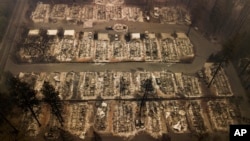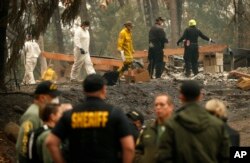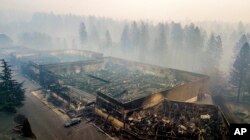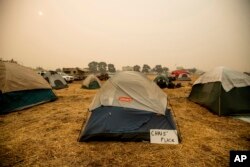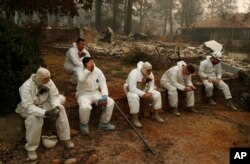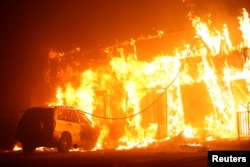Ten years ago, as two wildfires advanced on Paradise, residents jumped into their vehicles to flee and got stuck in gridlock. That led authorities to devise a staggered evacuation plan, one that they used when fire came again last week.
But Paradise’s carefully laid plans quickly devolved into a panicked exodus Nov. 8. Some survivors said that by the time they got the warnings, the flames were already extremely close, and they barely escaped with their lives. Others said they received no warnings at all.
Now, with at least 59 people dead and perhaps 300 unaccounted for in the nation’s deadliest wildfire in a century, authorities are facing questions of whether they took the right approach.
A lesson for towns across the West
It’s also a lesson for other communities across the West that could be threatened as climate change and overgrown forests contribute to longer, more destructive fire seasons.
Reeny Victoria Breevaart, who lives in Magalia, a forested community of 11,000 people north of Paradise, said she couldn’t receive warnings because cellphones weren’t working. She also lost electrical power.
Just over an hour after the first evacuation order was issued at 8 a.m., she said, neighbors came to her door to say: “You have to get out of here.”
Shari Bernacett, who with her husband managed a mobile home park in Paradise where they also lived, received a text ordering an evacuation.
“Within minutes the flames were on top of us,” she said.
Bernacett packed two duffel bags while her husband and another neighbor knocked on doors, yelling for people to get out. The couple grabbed their dog and drove through 12-foot (4-meter) flames to escape.
Evacuation orders
In the aftermath of the disaster, survivors said authorities need to devise a plan to reach residents who can’t get a cellphone signal in the hilly terrain or don’t have cellphones at all.
In his defense, Butte County Sheriff Kory Honea said evacuation orders were issued through 5,227 emails, 25,643 phone calls and 5,445 texts, in addition to social media and the use of loudspeakers. As cellphone service went down, authorities went into neighborhoods with bullhorns to tell people to leave, and that saved some lives.
Honea said he was too busy with the emergency and the recovery of human remains to analyze how the evacuation went. But he said it was a big, chaotic, fast-moving situation, and there weren’t enough law enforcement officers to go out and warn everyone.
“The fact that we have thousands and thousands of people in shelters would clearly indicate that we were able to notify a significant number of people,” the sheriff said.
Progress on fire
Some evacuees were staying in tents and cars at a Walmart parking lot and in a nearby field in Chico, though volunteers planning to close the makeshift shelter by Sunday were working to transition people to other locations.
A Sunday closure “gives us enough time to maybe figure something out,” said Mike Robertson, an evacuee who arrived there Monday with his wife and two daughters.
On Thursday, firefighters reported progress in battling the nearly 220-square-mile (570-square-kilometer) blaze. It was 40 percent contained, fire officials said. Crews slowed the flames’ advance on populated areas.
California Army National Guard members, wearing white jump suits, looked for human remains in the burned rubble, among more than 450 rescue workers assigned to the task.
President Donald Trump plans to travel to California on Saturday to visit victims of the wildfires burning at both ends of the state. Trump is unpopular in much of Democratic-leaning California but not in Butte County, which he carried by 4 percentage points over Hillary Clinton in the 2016 election.
The Paradise fire once again underscored shortcomings in warning systems.
Gov. Jerry Brown signed a bill in September requiring the development of statewide guidelines for Amber Alert-like warnings. A few Northern California communities are moving to install sirens after some wine country residents complained they didn’t receive warnings to evacuate ahead of a deadly wildfire in October 2017 that destroyed 5,300 homes.
Lessons from 2008
In 2008, the pair of wildfires that menaced Paradise destroyed 130 homes. No one was seriously hurt, but the chaos highlighted the need for a plan.
Paradise sits on a ridge between two higher hills, with only one main exit out of town. The best solution seemed to be to order evacuations in phases, so people didn’t get trapped.
“Gridlock is always the biggest concern,” said William Stewart, a forestry professor at the University of California, Berkeley.
Authorities developed an evacuation plan that split the town of 27,000 into zones and called for a staggered exodus. Paradise even conducted a mock evacuation during a morning commute, turning the main thoroughfare into a one-way street out of town.
Last week, when a wind-whipped fire bore down on the town, the sheriff’s department attempted an orderly, phased evacuation, instead of blasting a cellphone alert over an entire area.
‘No one could plan for a fire like that’
Phil John, chairman of the Paradise Ridge Fire Safe Council, defended the evacuation plan he helped develop. John said that the wildfire this time was exceptionally fast-moving and hot, and that no plan was going to work perfectly.
When the fire reached the eastern edge of Paradise, six zones were ordered to clear out about 8 a.m. But almost simultaneously, the gusting winds were carrying embers the size of dinner plates across town, and structures were catching fire throughout the city. Less than an hour later, the entire town was ordered evacuated.
“It didn’t work perfectly,” John said Thursday. “But no one could plan for a fire like that.”
Likewise, Stewart, the forestry professor, said the wildfire that hit Paradise disrupted the orderly evacuation plan because it “was moving too fast. All hell broke loose.”
Satellite images show half the town on fire less than two hours after the first evacuation order.
Stewart said experts continue to debate how best to issue evacuation orders and no ideal solution has been found.
At the other end of the state, meanwhile, crews continued to gain ground against a blaze of more than 153 square miles (396 square kilometers) that destroyed over 500 structures in Malibu and other Southern California communities.
At least three deaths were reported.




